
LL3DA
[CVPR 2024] "LL3DA: Visual Interactive Instruction Tuning for Omni-3D Understanding, Reasoning, and Planning"; an interactive Large Language 3D Assistant.
Stars: 207
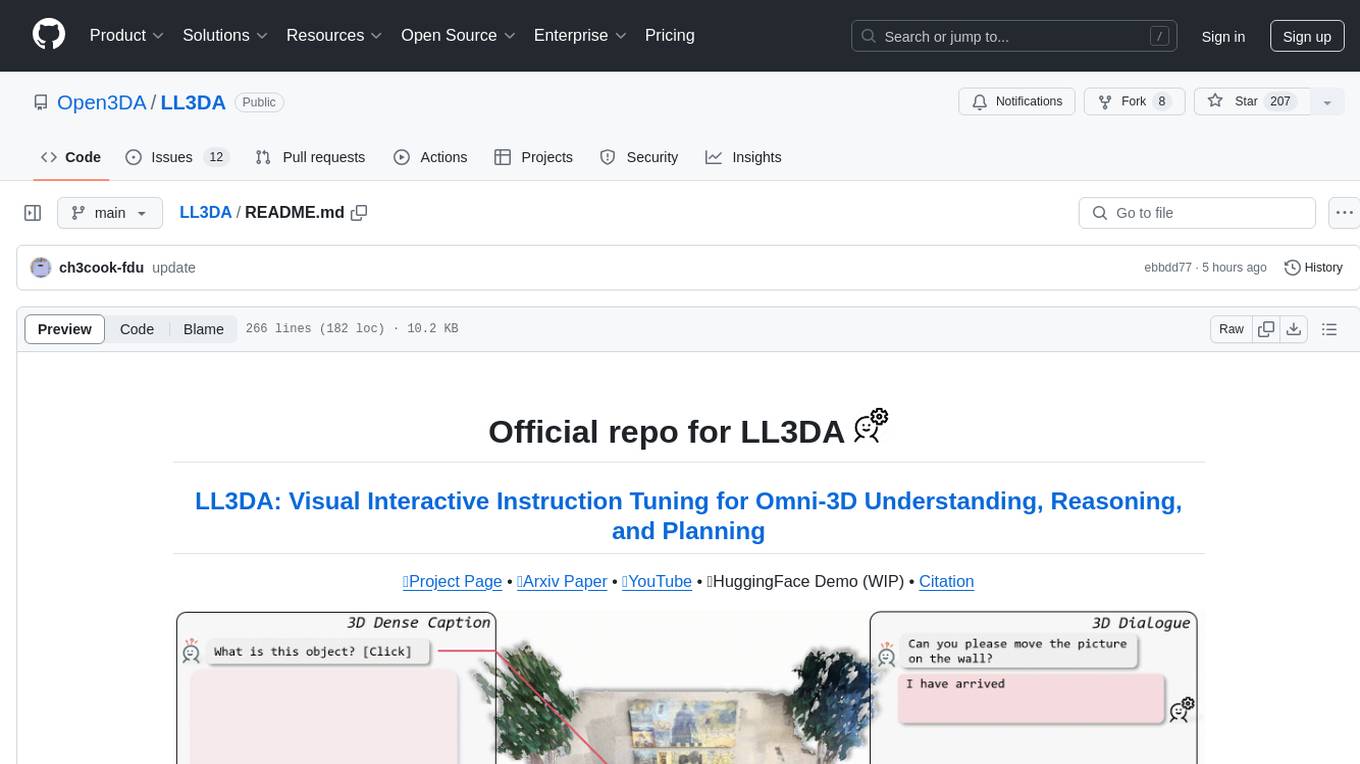
LL3DA is a Large Language 3D Assistant that responds to both visual and textual interactions within complex 3D environments. It aims to help Large Multimodal Models (LMM) comprehend, reason, and plan in diverse 3D scenes by directly taking point cloud input and responding to textual instructions and visual prompts. LL3DA achieves remarkable results in 3D Dense Captioning and 3D Question Answering, surpassing various 3D vision-language models. The code is fully released, allowing users to train customized models and work with pre-trained weights. The tool supports training with different LLM backends and provides scripts for tuning and evaluating models on various tasks.
README:
💻Project Page • 📄Arxiv Paper • 🎞YouTube • 🤗HuggingFace Demo (WIP) • Citation
LL3DA is a Large Language 3D Assistant that could respond to both visual and textual interactions within complex 3D environments.
Recent advances in Large Multimodal Models (LMM) have made it possible for various applications in human-machine interactions. However, developing LMMs that can comprehend, reason, and plan in complex and diverse 3D environments remains a challenging topic, especially considering the demand for understanding permutation-invariant point cloud 3D representations of the 3D scene. Existing works seek help from multi-view images, and project 2D features to 3D space as 3D scene representations. This, however, leads to huge computational overhead and performance degradation. In this paper, we present LL3DA, a Large Language 3D Assistant that takes point cloud as direct input and respond to both textual-instructions and visual-prompts. This help LMMs better comprehend human interactions and further help to remove the ambiguities in cluttered 3D scenes. Experiments show that LL3DA achieves remarkable results, and surpasses various 3D vision-language models on both 3D Dense Captioning and 3D Question Answering.
- 2024-03-04. 💥 The code is fully released! Now you can train your customized models!
- 2024-02-27. 🎉 LL3DA is accepted by CVPR 2024! See you in Seattle!
- 2023-11-30. 📣 Upload paper and init project
TODO:
- [x] Upload our paper to arXiv and build project pages.
- [x] Pray for acceptance.
- [x] Upload all the code and training scripts.
- [x] Release pre-trained weights. (see checkpoint)
- [ ] Add local demo interface.
- [ ] Train on larger 3D VL benchmarks and scale up models.
Environment Setup
Step 1. Build Dependencies. Our code is tested with CUDA 11.6 and Python 3.8.16. To run the codes, you should first install the following packages:
h5py
scipy
cython
plyfile
'trimesh>=2.35.39,<2.35.40'
'networkx>=2.2,<2.3'
'torch=1.13.1+cu116'
'transformers>=4.37.0'
After that, build the pointnet2 and accelerated giou from source:
cd third_party/pointnet2
python setup.py install
cd utils
python cython_compile.py build_ext --inplace
Step 2. Download pre-trained embeddings. Download the pre-processed BERT embedding weights from huggingface and store them under the ./bert-base-embedding folder. The weights are the same from the official BERT model, we just modified the names of certain parameters.
Data Preparation
Our repo requires the 3D data from ScanNet, the natural language annotations, and the pre-trained LLM weights.
Step 1. Download and Prepare the ScanNet 3D Data.
Updates 2024-07-01: You can download the pre-processed data from here.
- Follow the instructions here and download the ScanNetV2 dataset.
- Change the
SCANNET_DIRto the scans folder indata/scannet/batch_load_scannet_data.py, and run the following commands.
cd data/scannet/
python batch_load_scannet_data.py
Step 2. Prepare Language Annotations
To train the model, you are required to prepare language annotations from ScanRefer, Nr3D, ScanQA, and the ScanNet part of 3D-LLM.
-
ScanRefer. Follow the commands here to download theScanReferdataset. -
Nr3D. Follow the commands here to download theNr3Ddataset, and pre-process it. -
ScanQA. Follow the commands here to download theScanQAdataset. -
3D-LLM. The data are located at here. We have also shared our pre-processing scripts here.
We will update the latest released data (V3) from 3D-LLM.
Finally, organize the files into the following folders:
./data/
ScanRefer/
ScanRefer_filtered_train.json
ScanRefer_filtered_train.txt
ScanRefer_filtered_val.json
ScanRefer_filtered_val.txt
Nr3D/
nr3d_train.json
nr3d_train.txt
nr3d_val.json
nr3d_val.txt
ScanQA/
ScanQA_v1.0_test_w_obj.json
ScanQA_v1.0_test_wo_obj.json
ScanQA_v1.0_train.json
ScanQA_v1.0_val.json
3D_LLM/
3d_llm_embodied_dialogue_filtered_train.json
3d_llm_embodied_dialogue_filtered_val.json
3d_llm_embodied_planning_filtered_train.json
3d_llm_embodied_planning_filtered_val.json
3d_llm_scene_description_train.json
3d_llm_scene_description_val.json
Step 3. [Optional] Download Pre-trained LLM weights. If your server has no trouble auto-downloading weights from huggingface🤗, feel free to skip this step.
Download files from the opt-1.3b checkpoint (or any other decoder-only LLM) at huggingface, and store them under the ./facebook/opt-1.3b directory. Make sure the required files are downloaded:
./facebook/opt-1.3b/
config.json
merges.txt
pytorch_model.bin
special_tokens_map.json
tokenizer_config.json
vocab.json
Updates 2024-07-01: The released version is slightly different from our paper implementation. In our released version, we standardized the data format and dropped duplicated text annotations. To reproduce our reported results, please use the scripts provided in scripts-v0 to produce the generalist weights.
bash scripts-v0/opt-1.3b/train.generalist.sh
Our code should support any decoder-only LLMs (facebook/opt-1.3b, gpt2-xl, meta-llama/Llama-2-7b or even the LATEST Qwen/Qwen1.5-1.8B and Qwen/Qwen1.5-4B). Check out the following table for recommended LLMs in different scales! By default, the models are trained with eight GPUs.
| <1B | 1B-4B | ~7B |
|---|---|---|
gpt2(124m) |
TinyLlama-1.1B(1.1b) |
facebook/opt-6.7b(6.7b) |
facebook/opt-125m(125m) |
facebook/opt-1.3b(1.3b) |
meta-llama/Llama-2-7b-hf(6.7b) |
gpt2-medium(355m) |
gpt2-xl(1.6b) |
Qwen/Qwen1.5-7B(7.7b) |
Qwen/Qwen1.5-0.5B(620m) |
Qwen/Qwen1.5-1.8B(1.8b) |
- |
gpt2-large(774m) |
facebook/opt-2.7b(2.7b) |
- |
| - |
microsoft/phi-2(2.8b) |
- |
| - |
Qwen/Qwen1.5-4B(3.9b) |
- |
We provide training scripts in the scripts folder with different LLM backends. Feel free to modify the hyper parameters in those commands.
For other LLM backends, please modify the commands manually by changing --vocab to other LLMs.
Training
To train the model as a 3D generalist: (We have also uploaded the pre-trained weights to huggingface.)
bash scripts/opt-1.3b/train.generalist.sh
After the model is trained, you can tune the model on ScanQA for 3D Question Answering:
bash scripts/opt-1.3b/tuning.scanqa.sh
And, on ScanRefer / Nr3D for 3D Dense Captioning:
bash scripts/opt-1.3b/tuning.scanrefer.sh
bash scripts/opt-1.3b/tuning.nr3d.sh
You can also tune the model to predict bounding boxes for open vocabulary object detection!
bash scripts/opt-1.3b/tuning.ovdet.sh
Evaluation
To evaluate the model as a 3D generalist:
bash scripts/opt-1.3b/eval.generalist.sh
On ScanQA for 3D Question Answering:
bash scripts/opt-1.3b/eval.scanqa.sh
And, on ScanRefer / Nr3D for 3D Dense Captioning:
bash scripts/opt-1.3b/eval.scanrefer.sh
bash scripts/opt-1.3b/eval.nr3d.sh
If you find our code or paper helpful, please consider starring ⭐ us and citing:
@misc{chen2023ll3da,
title={LL3DA: Visual Interactive Instruction Tuning for Omni-3D Understanding, Reasoning, and Planning},
author={Sijin Chen and Xin Chen and Chi Zhang and Mingsheng Li and Gang Yu and Hao Fei and Hongyuan Zhu and Jiayuan Fan and Tao Chen},
year={2023},
eprint={2311.18651},
archivePrefix={arXiv},
primaryClass={cs.CV}
}
Thanks to Vote2Cap-DETR, 3D-LLM, Scan2Cap, and 3DETR. We borrow some of their codes and data.
This code is distributed under an MIT LICENSE. If there are any problem regarding our paper and code, feel free to open an issue!
For Tasks:
Click tags to check more tools for each tasksFor Jobs:
Alternative AI tools for LL3DA
Similar Open Source Tools

LL3DA
LL3DA is a Large Language 3D Assistant that responds to both visual and textual interactions within complex 3D environments. It aims to help Large Multimodal Models (LMM) comprehend, reason, and plan in diverse 3D scenes by directly taking point cloud input and responding to textual instructions and visual prompts. LL3DA achieves remarkable results in 3D Dense Captioning and 3D Question Answering, surpassing various 3D vision-language models. The code is fully released, allowing users to train customized models and work with pre-trained weights. The tool supports training with different LLM backends and provides scripts for tuning and evaluating models on various tasks.
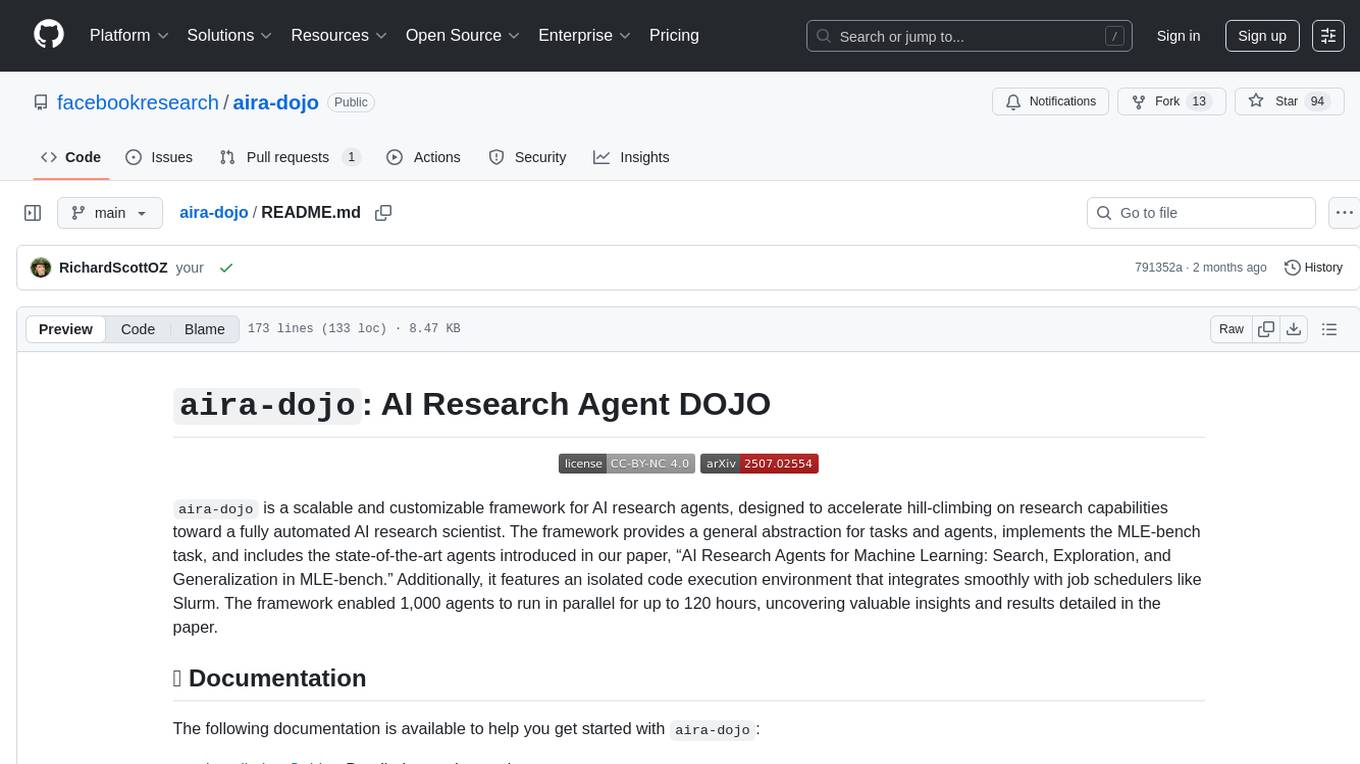
aira-dojo
aira-dojo is a scalable and customizable framework for AI research agents, designed to accelerate hill-climbing on research capabilities toward a fully automated AI research scientist. The framework provides a general abstraction for tasks and agents, implements the MLE-bench task, and includes state-of-the-art agents. It features an isolated code execution environment that integrates smoothly with job schedulers like Slurm, enabling large-scale experiments and rapid iteration across a portfolio of tasks and solvers.
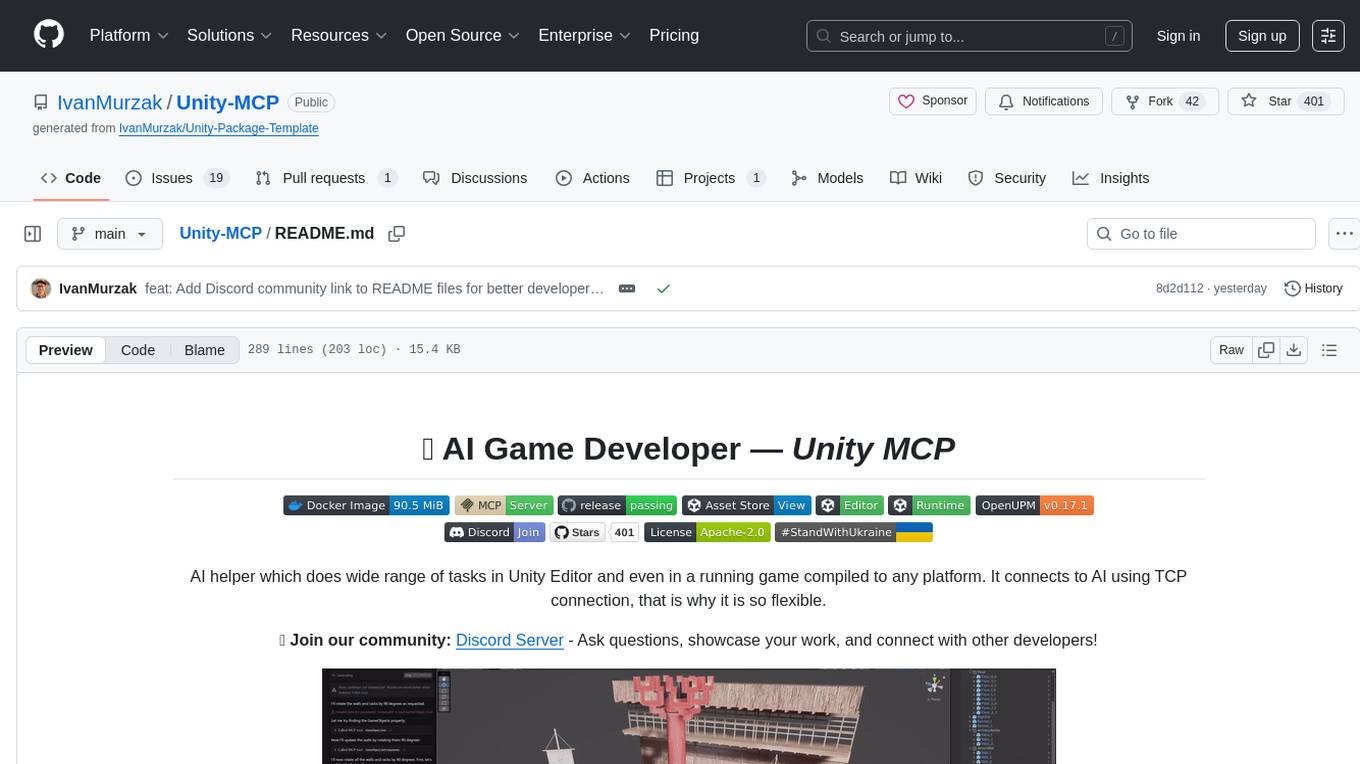
Unity-MCP
Unity-MCP is an AI helper designed for game developers using Unity. It facilitates a wide range of tasks in Unity Editor and running games on any platform by connecting to AI via TCP connection. The tool allows users to chat with AI like with a human, supports local and remote usage, and offers various default AI tools. Users can provide detailed information for classes, fields, properties, and methods using the 'Description' attribute in C# code. Unity-MCP enables instant C# code compilation and execution, provides access to assets and C# scripts, and offers tools for proper issue understanding and project data manipulation. It also allows users to find and call methods in the codebase, work with Unity API, and access human-readable descriptions of code elements.
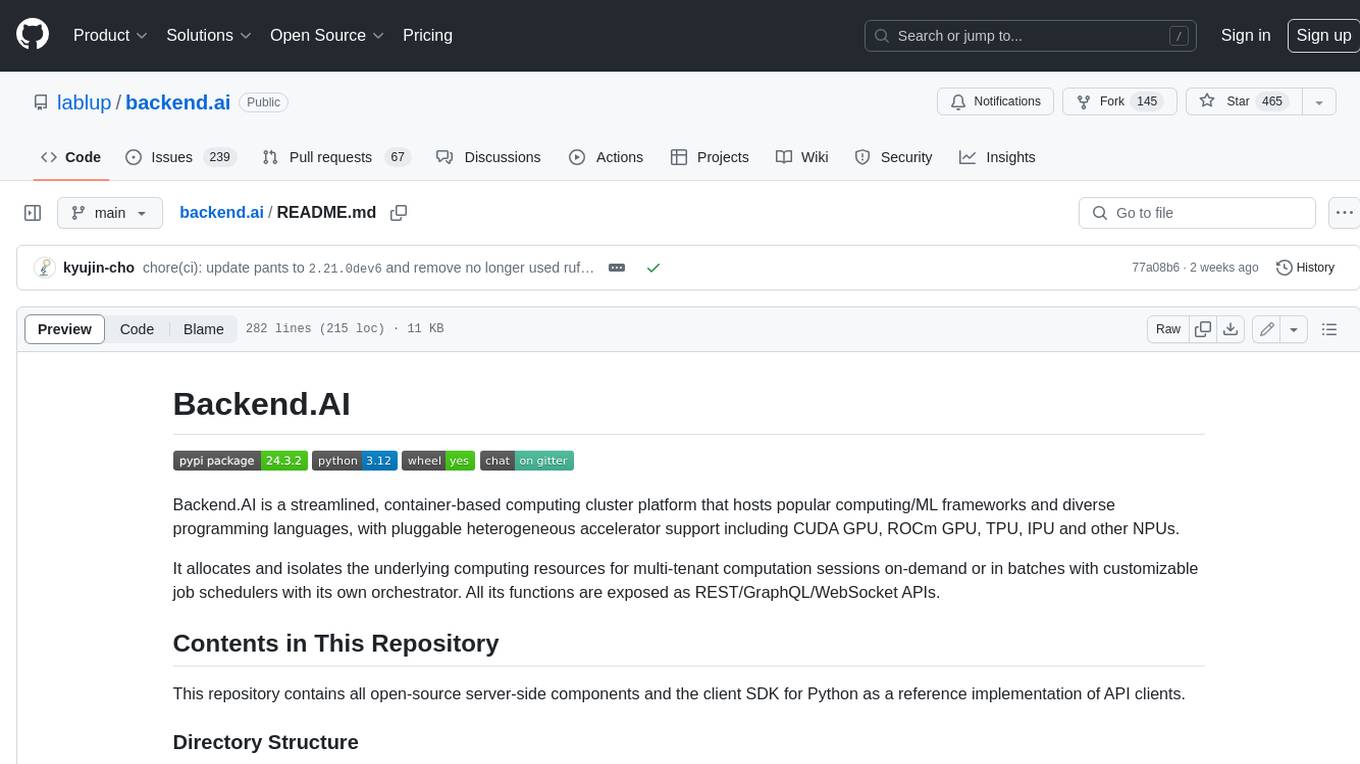
backend.ai
Backend.AI is a streamlined, container-based computing cluster platform that hosts popular computing/ML frameworks and diverse programming languages, with pluggable heterogeneous accelerator support including CUDA GPU, ROCm GPU, TPU, IPU and other NPUs. It allocates and isolates the underlying computing resources for multi-tenant computation sessions on-demand or in batches with customizable job schedulers with its own orchestrator. All its functions are exposed as REST/GraphQL/WebSocket APIs.
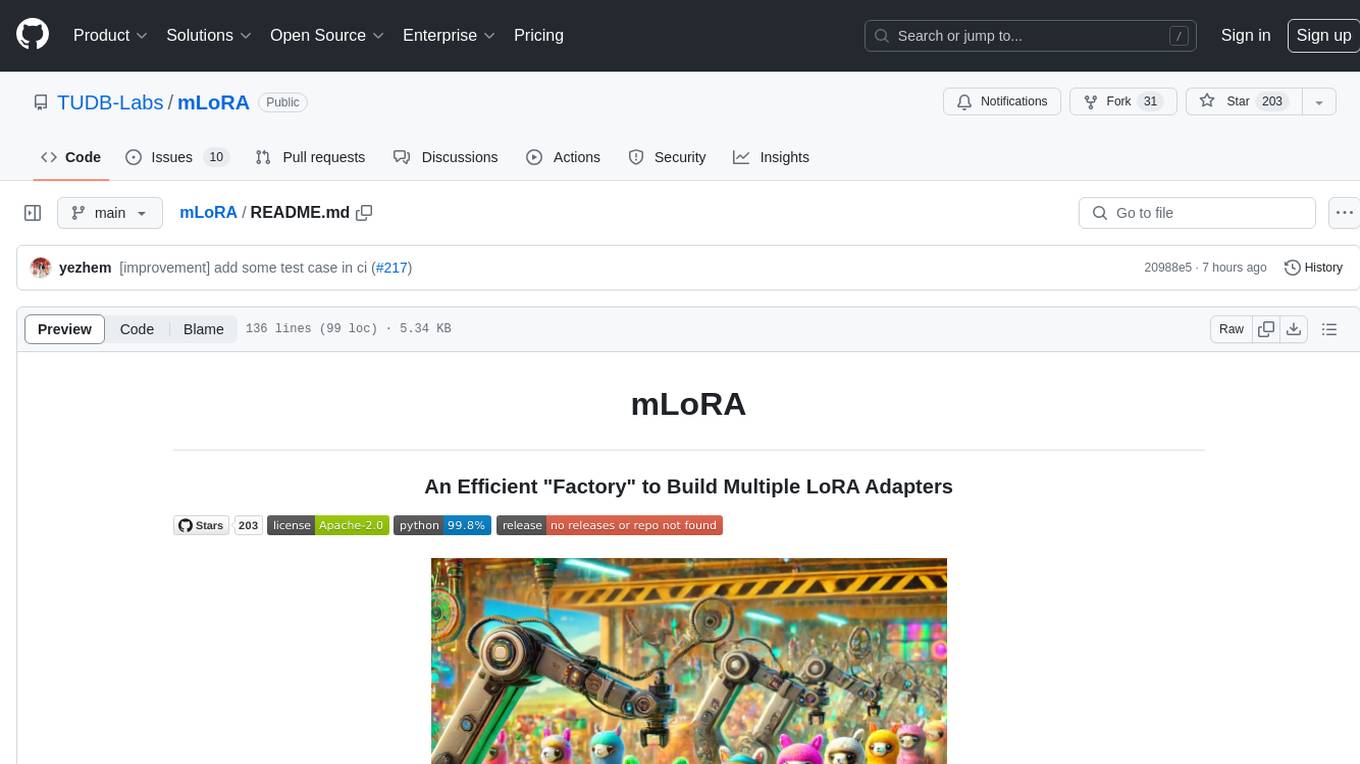
mLoRA
mLoRA (Multi-LoRA Fine-Tune) is an open-source framework for efficient fine-tuning of multiple Large Language Models (LLMs) using LoRA and its variants. It allows concurrent fine-tuning of multiple LoRA adapters with a shared base model, efficient pipeline parallelism algorithm, support for various LoRA variant algorithms, and reinforcement learning preference alignment algorithms. mLoRA helps save computational and memory resources when training multiple adapters simultaneously, achieving high performance on consumer hardware.
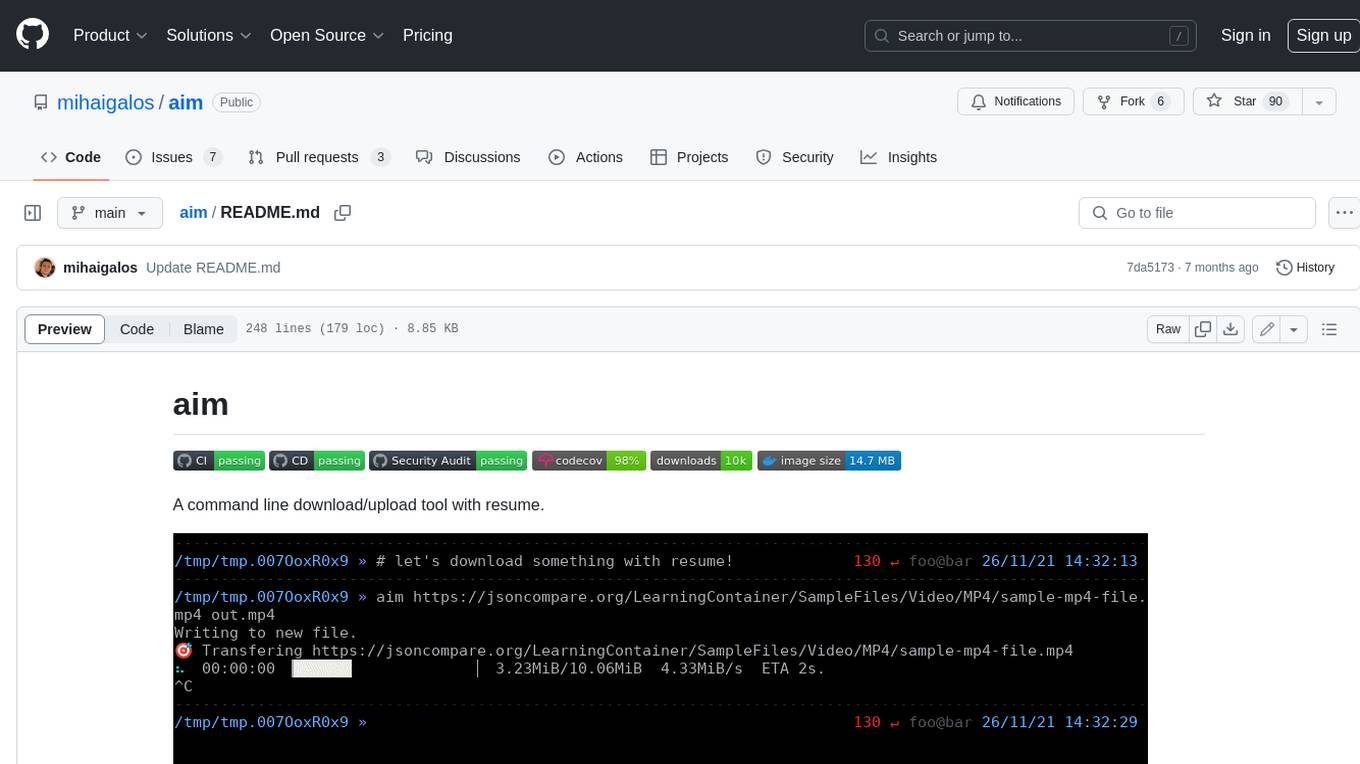
aim
Aim is a command-line tool for downloading and uploading files with resume support. It supports various protocols including HTTP, FTP, SFTP, SSH, and S3. Aim features an interactive mode for easy navigation and selection of files, as well as the ability to share folders over HTTP for easy access from other devices. Additionally, it offers customizable progress indicators and output formats, and can be integrated with other commands through piping. Aim can be installed via pre-built binaries or by compiling from source, and is also available as a Docker image for platform-independent usage.
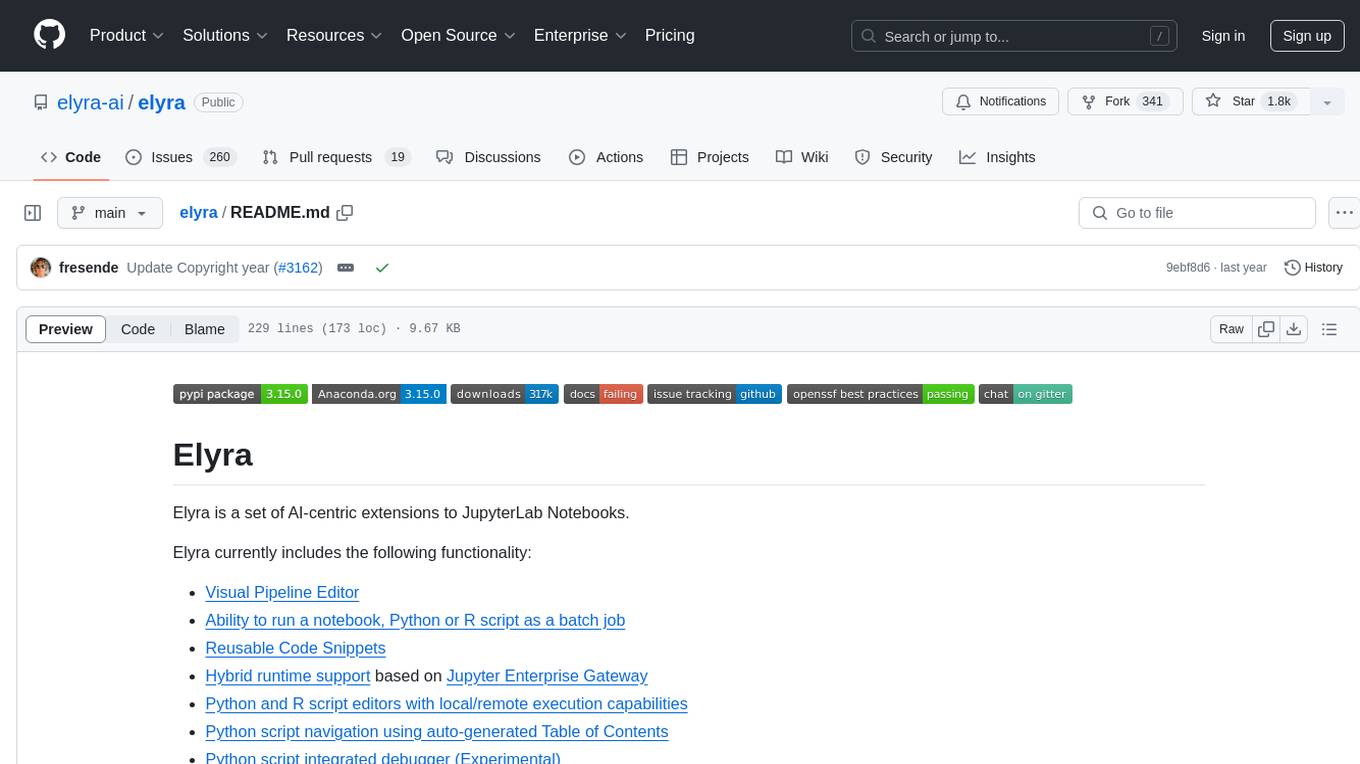
elyra
Elyra is a set of AI-centric extensions to JupyterLab Notebooks that includes features like Visual Pipeline Editor, running notebooks/scripts as batch jobs, reusable code snippets, hybrid runtime support, script editors with execution capabilities, debugger, version control using Git, and more. It provides a comprehensive environment for data scientists and AI practitioners to develop, test, and deploy machine learning models and workflows efficiently.
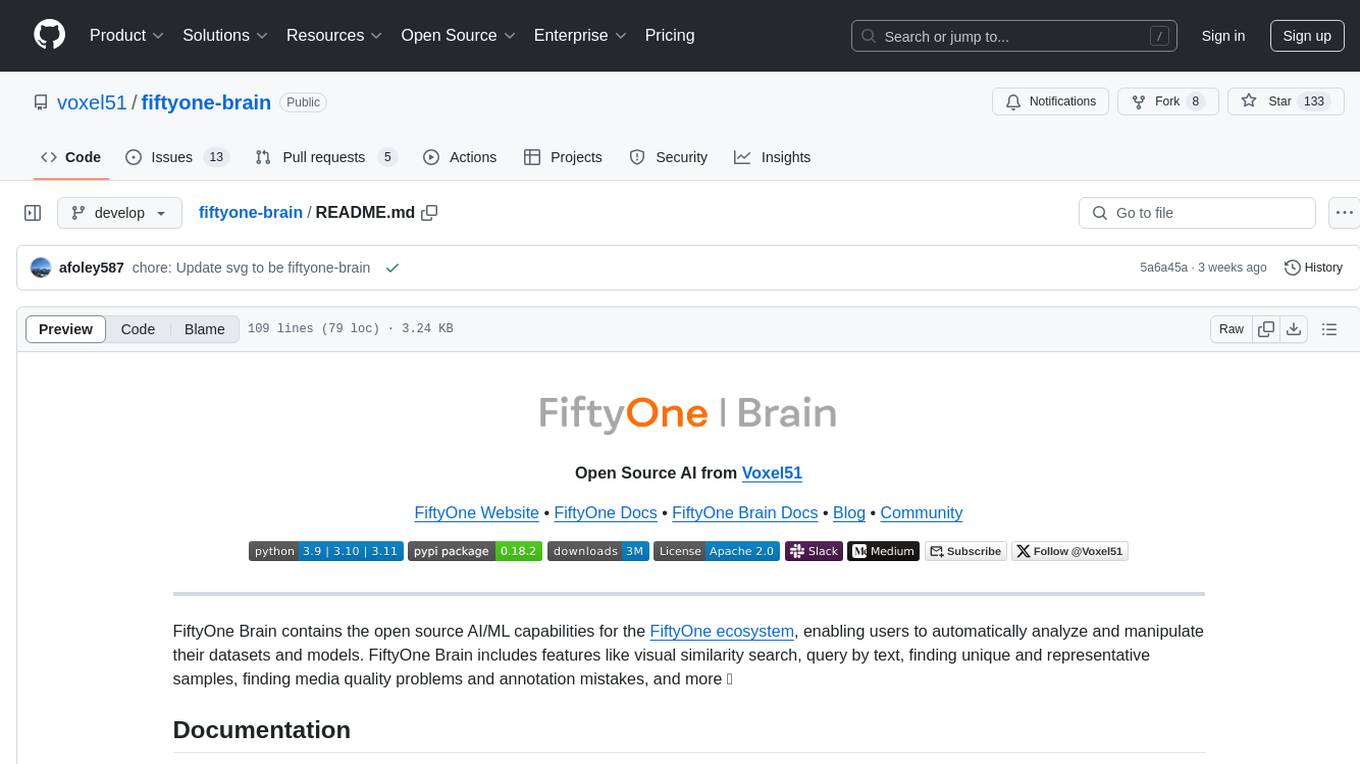
fiftyone-brain
FiftyOne Brain contains the open source AI/ML capabilities for the FiftyOne ecosystem, enabling users to automatically analyze and manipulate their datasets and models. Features include visual similarity search, query by text, finding unique and representative samples, finding media quality problems and annotation mistakes, and more.
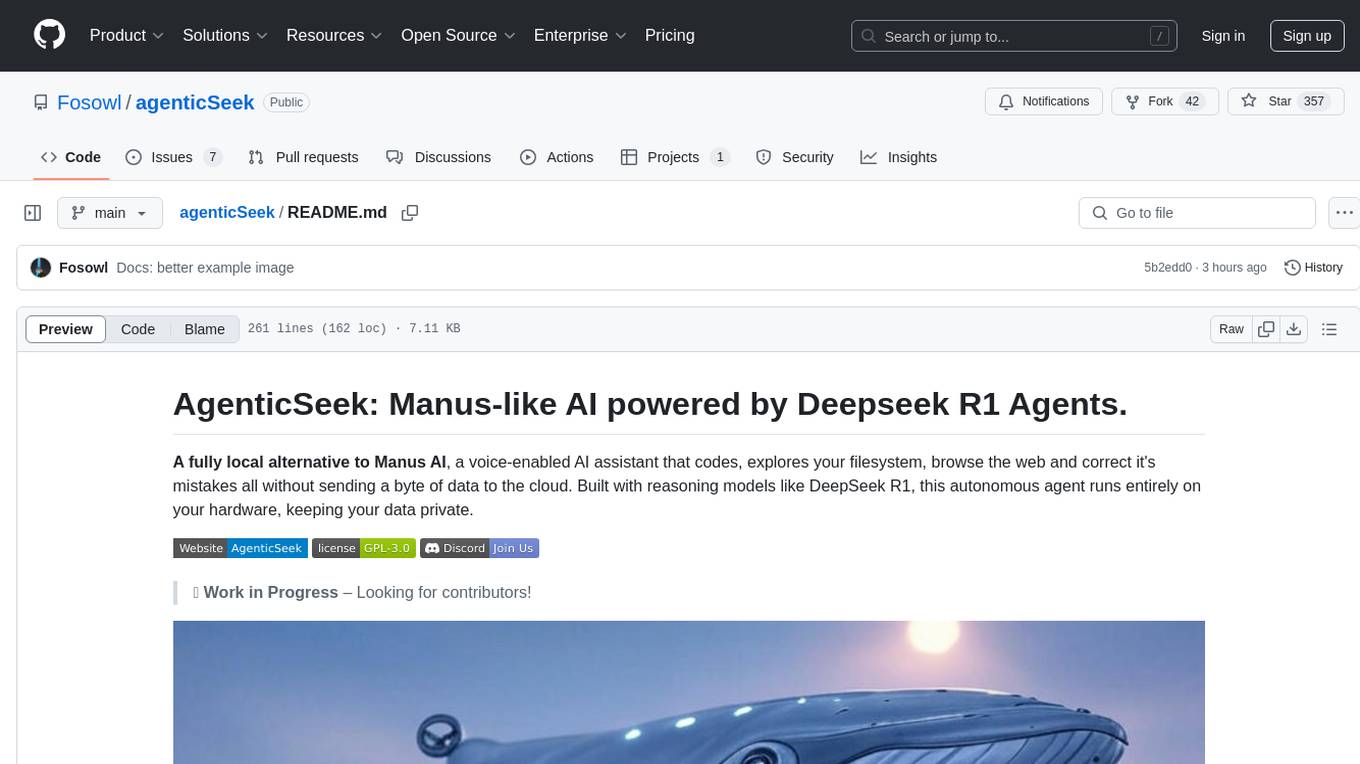
agenticSeek
AgenticSeek is a voice-enabled AI assistant powered by DeepSeek R1 agents, offering a fully local alternative to cloud-based AI services. It allows users to interact with their filesystem, code in multiple languages, and perform various tasks autonomously. The tool is equipped with memory to remember user preferences and past conversations, and it can divide tasks among multiple agents for efficient execution. AgenticSeek prioritizes privacy by running entirely on the user's hardware without sending data to the cloud.
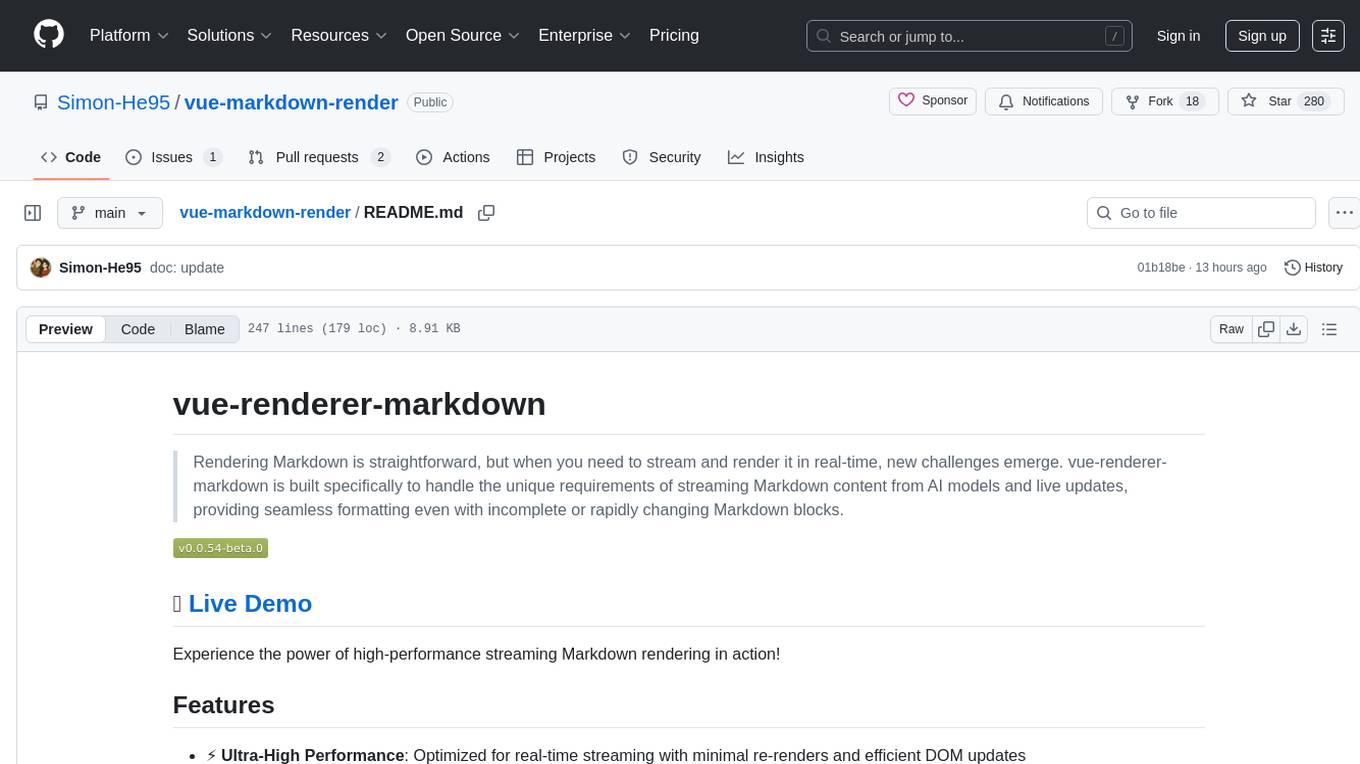
vue-markdown-render
vue-renderer-markdown is a high-performance tool designed for streaming and rendering Markdown content in real-time. It is optimized for handling incomplete or rapidly changing Markdown blocks, making it ideal for scenarios like AI model responses, live content updates, and real-time Markdown rendering. The tool offers features such as ultra-high performance, streaming-first design, Monaco integration, progressive Mermaid rendering, custom components integration, complete Markdown support, real-time updates, TypeScript support, and zero configuration setup. It solves challenges like incomplete syntax blocks, rapid content changes, cursor positioning complexities, and graceful handling of partial tokens with a streaming-optimized architecture.
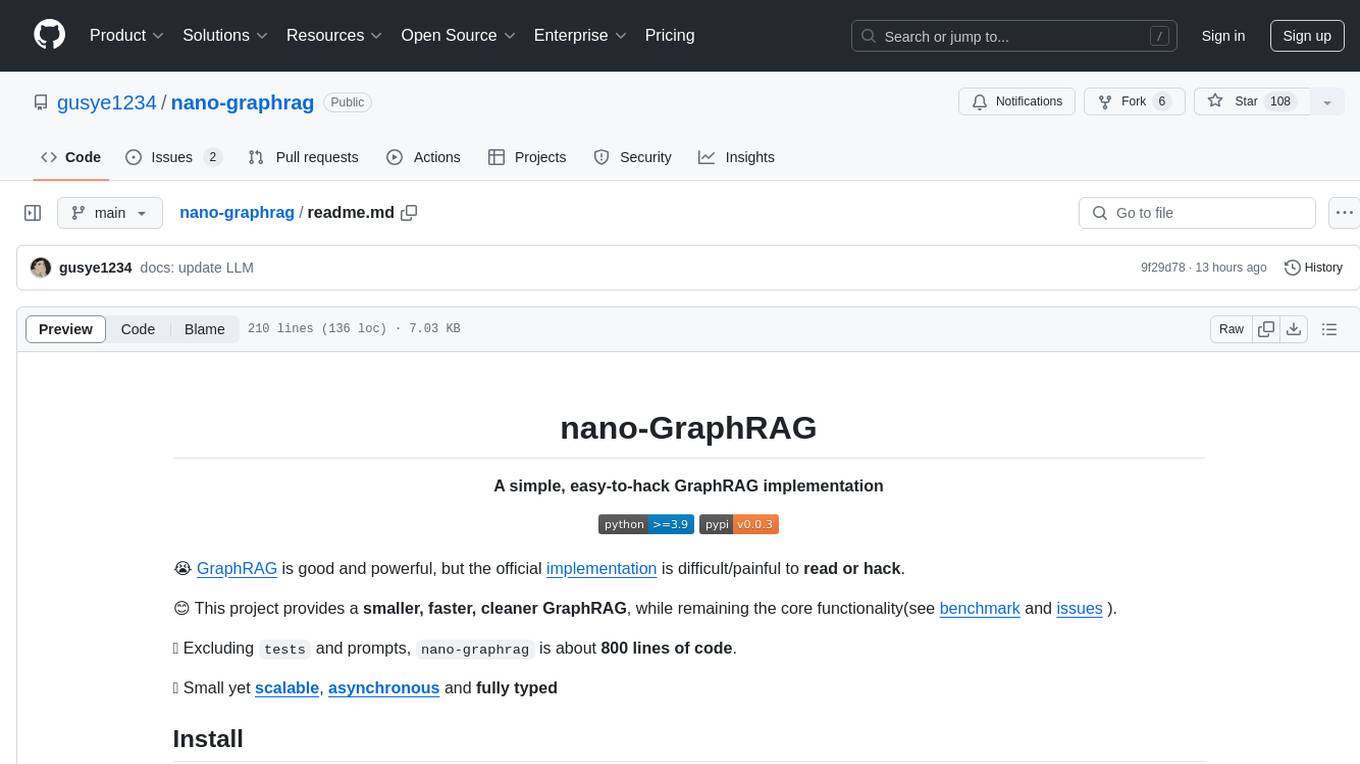
nano-graphrag
nano-GraphRAG is a simple, easy-to-hack implementation of GraphRAG that provides a smaller, faster, and cleaner version of the official implementation. It is about 800 lines of code, small yet scalable, asynchronous, and fully typed. The tool supports incremental insert, async methods, and various parameters for customization. Users can replace storage components and LLM functions as needed. It also allows for embedding function replacement and comes with pre-defined prompts for entity extraction and community reports. However, some features like covariates and global search implementation differ from the original GraphRAG. Future versions aim to address issues related to data source ID, community description truncation, and add new components.
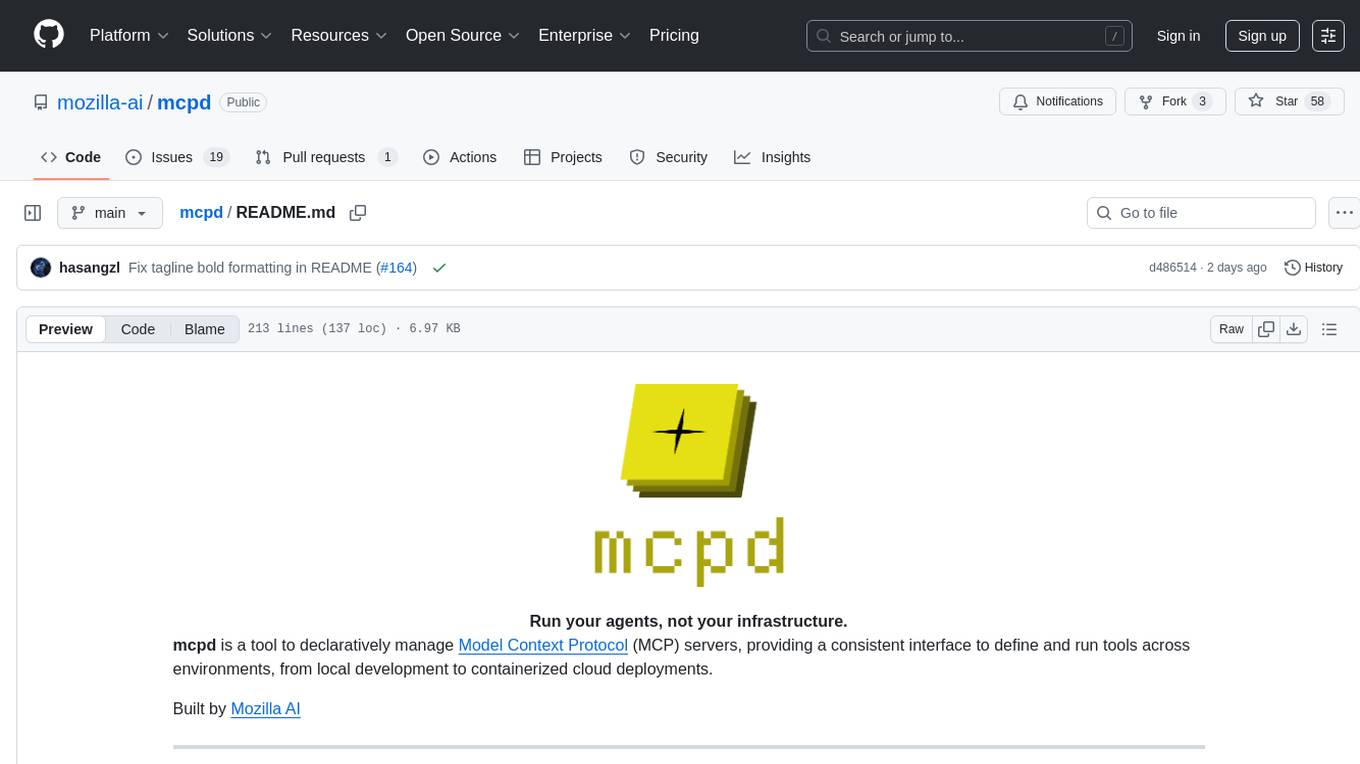
mcpd
mcpd is a tool developed by Mozilla AI to declaratively manage Model Context Protocol (MCP) servers, enabling consistent interface for defining and running tools across different environments. It bridges the gap between local development and enterprise deployment by providing secure secrets management, declarative configuration, and seamless environment promotion. mcpd simplifies the developer experience by offering zero-config tool setup, language-agnostic tooling, version-controlled configuration files, enterprise-ready secrets management, and smooth transition from local to production environments.
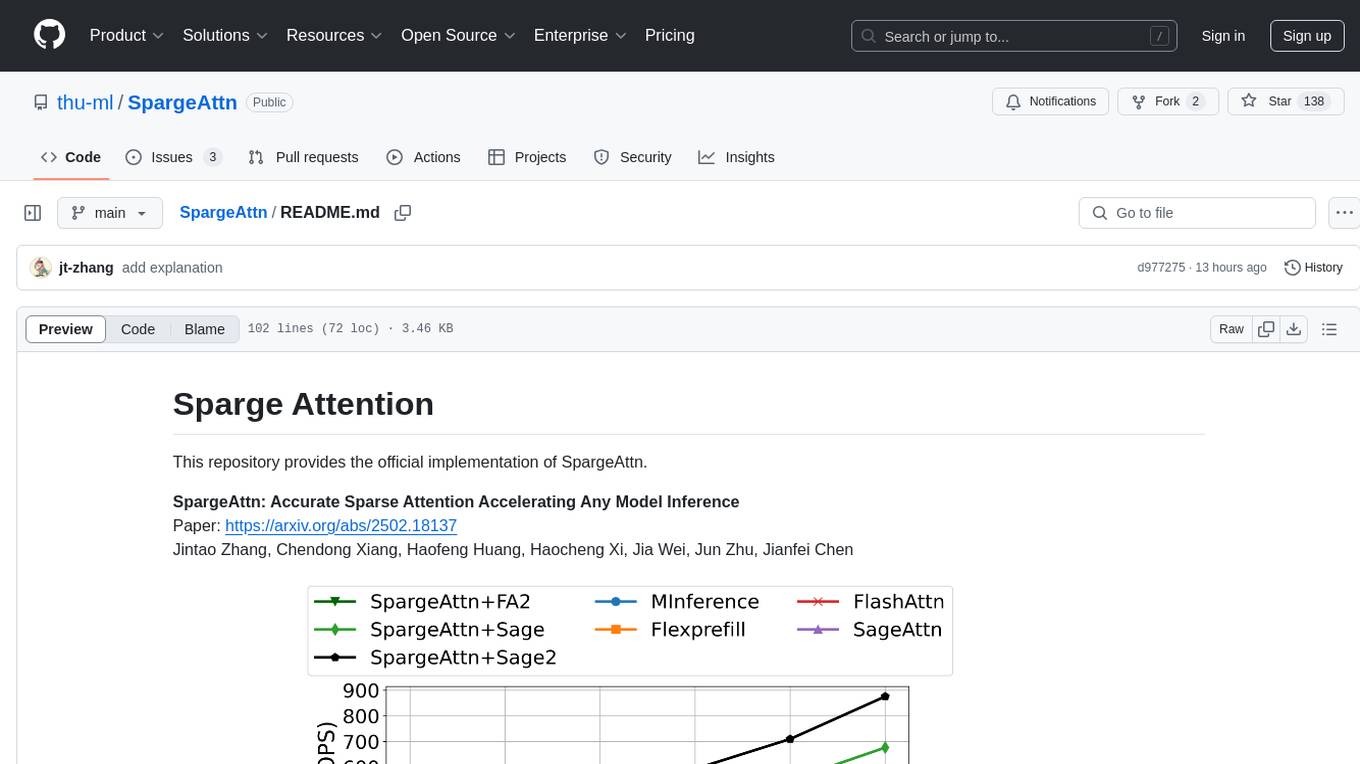
SpargeAttn
SpargeAttn is an official implementation designed for accelerating any model inference by providing accurate sparse attention. It offers a significant speedup in model performance while maintaining quality. The tool is based on SageAttention and SageAttention2, providing options for different levels of optimization. Users can easily install the package and utilize the available APIs for their specific needs. SpargeAttn is particularly useful for tasks requiring efficient attention mechanisms in deep learning models.
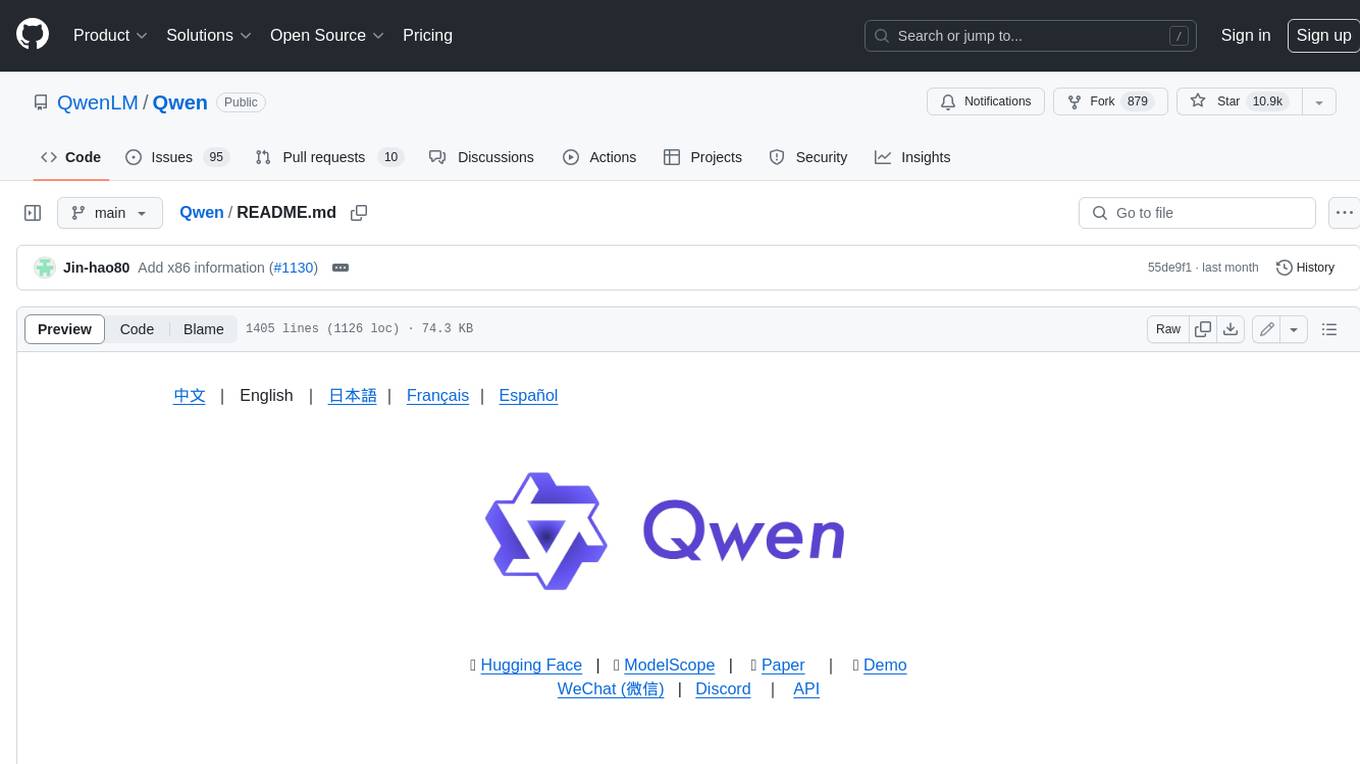
Qwen
Qwen is a series of large language models developed by Alibaba DAMO Academy. It outperforms the baseline models of similar model sizes on a series of benchmark datasets, e.g., MMLU, C-Eval, GSM8K, MATH, HumanEval, MBPP, BBH, etc., which evaluate the models’ capabilities on natural language understanding, mathematic problem solving, coding, etc. Qwen models outperform the baseline models of similar model sizes on a series of benchmark datasets, e.g., MMLU, C-Eval, GSM8K, MATH, HumanEval, MBPP, BBH, etc., which evaluate the models’ capabilities on natural language understanding, mathematic problem solving, coding, etc. Qwen-72B achieves better performance than LLaMA2-70B on all tasks and outperforms GPT-3.5 on 7 out of 10 tasks.
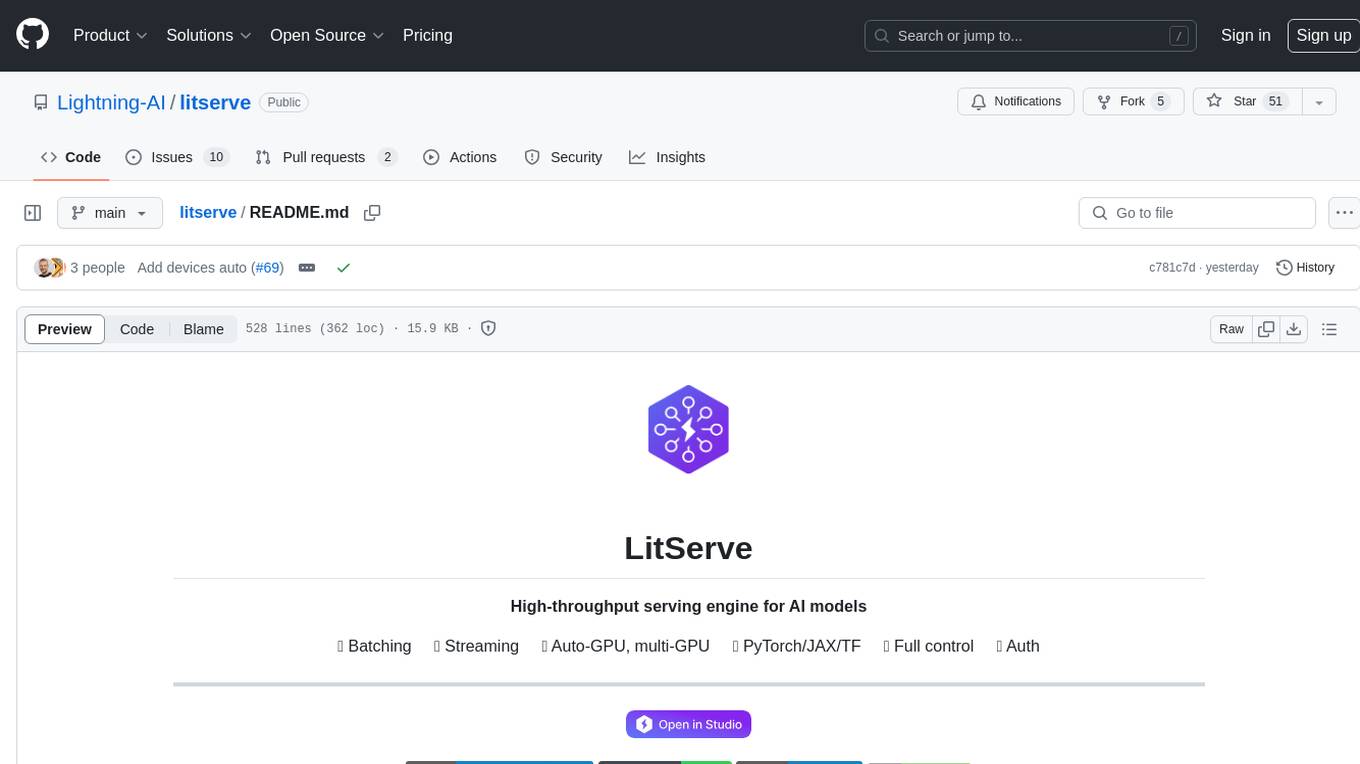
litserve
LitServe is a high-throughput serving engine for deploying AI models at scale. It generates an API endpoint for a model, handles batching, streaming, autoscaling across CPU/GPUs, and more. Built for enterprise scale, it supports every framework like PyTorch, JAX, Tensorflow, and more. LitServe is designed to let users focus on model performance, not the serving boilerplate. It is like PyTorch Lightning for model serving but with broader framework support and scalability.
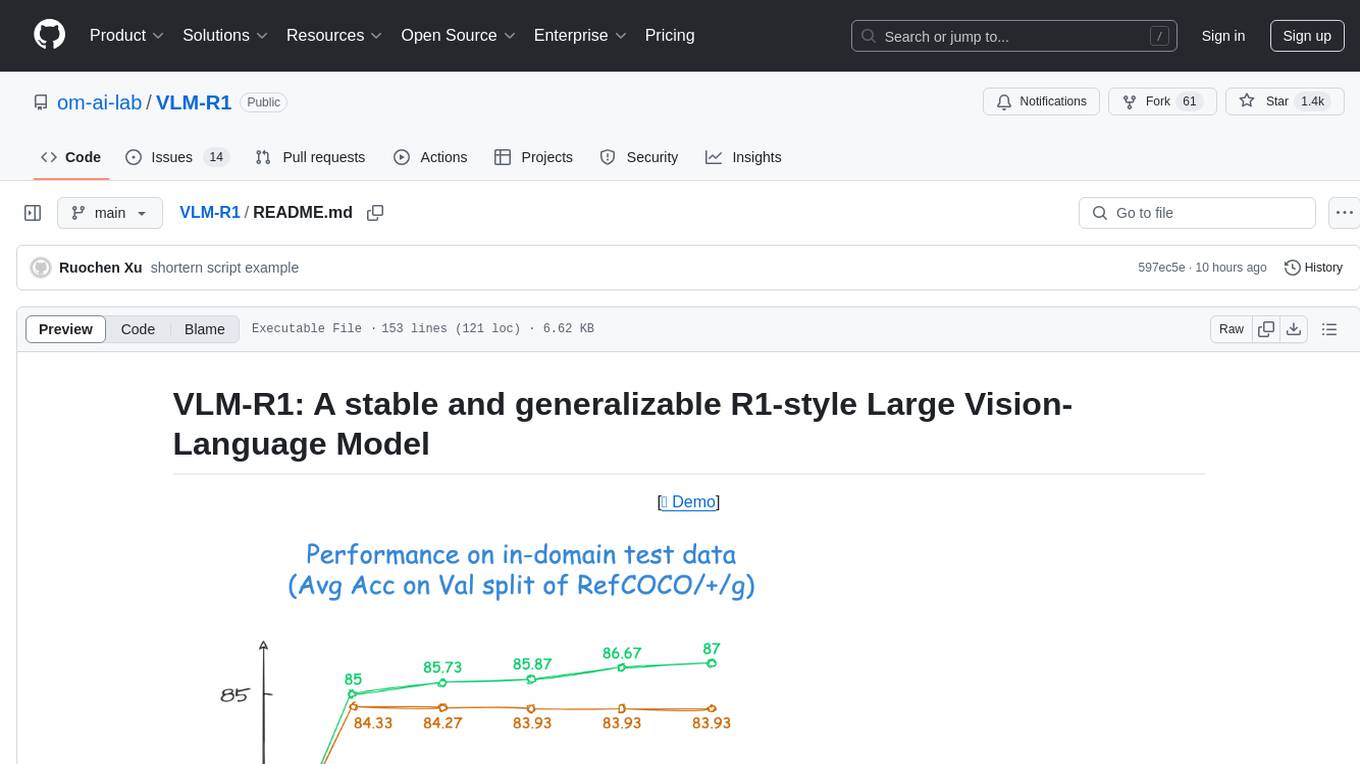
VLM-R1
VLM-R1 is a stable and generalizable R1-style Large Vision-Language Model proposed for Referring Expression Comprehension (REC) task. It compares R1 and SFT approaches, showing R1 model's steady improvement on out-of-domain test data. The project includes setup instructions, training steps for GRPO and SFT models, support for user data loading, and evaluation process. Acknowledgements to various open-source projects and resources are mentioned. The project aims to provide a reliable and versatile solution for vision-language tasks.
For similar tasks

LL3DA
LL3DA is a Large Language 3D Assistant that responds to both visual and textual interactions within complex 3D environments. It aims to help Large Multimodal Models (LMM) comprehend, reason, and plan in diverse 3D scenes by directly taking point cloud input and responding to textual instructions and visual prompts. LL3DA achieves remarkable results in 3D Dense Captioning and 3D Question Answering, surpassing various 3D vision-language models. The code is fully released, allowing users to train customized models and work with pre-trained weights. The tool supports training with different LLM backends and provides scripts for tuning and evaluating models on various tasks.
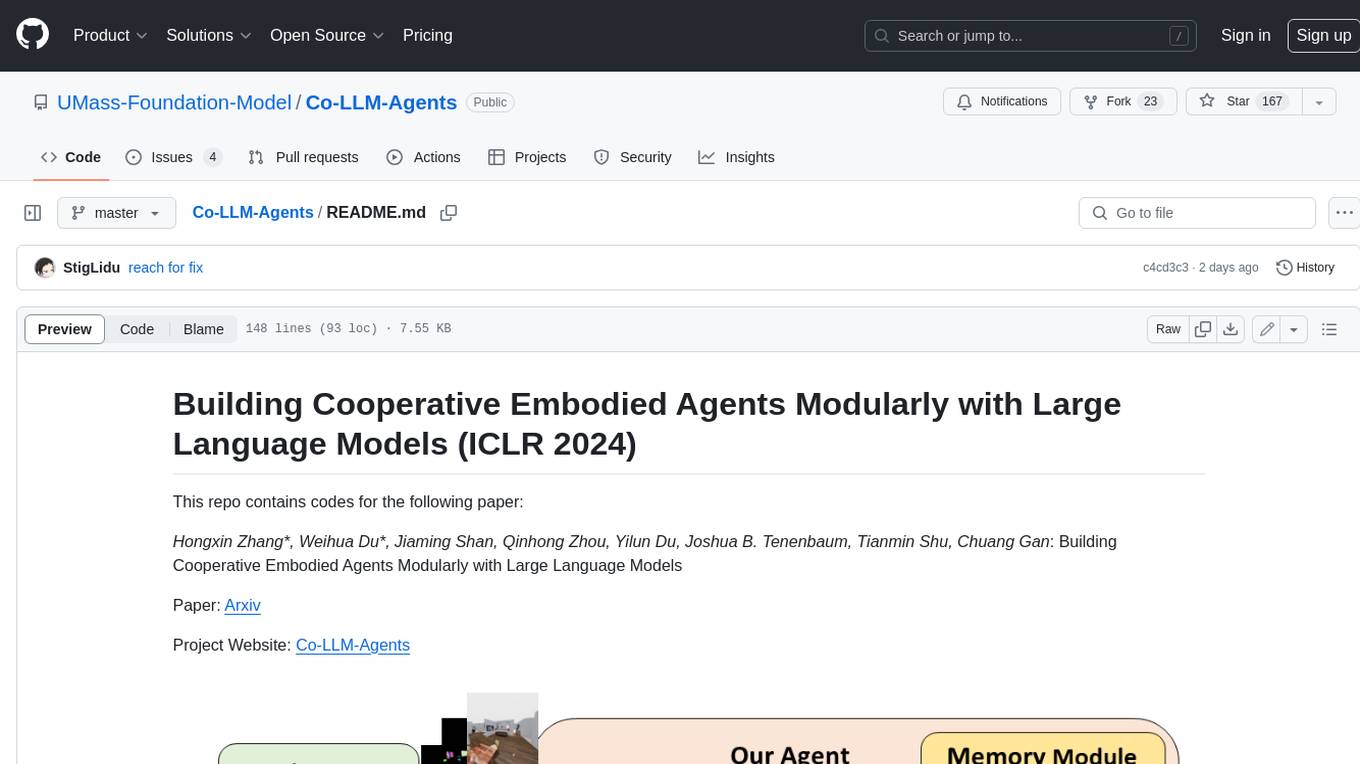
Co-LLM-Agents
This repository contains code for building cooperative embodied agents modularly with large language models. The agents are trained to perform tasks in two different environments: ThreeDWorld Multi-Agent Transport (TDW-MAT) and Communicative Watch-And-Help (C-WAH). TDW-MAT is a multi-agent environment where agents must transport objects to a goal position using containers. C-WAH is an extension of the Watch-And-Help challenge, which enables agents to send messages to each other. The code in this repository can be used to train agents to perform tasks in both of these environments.
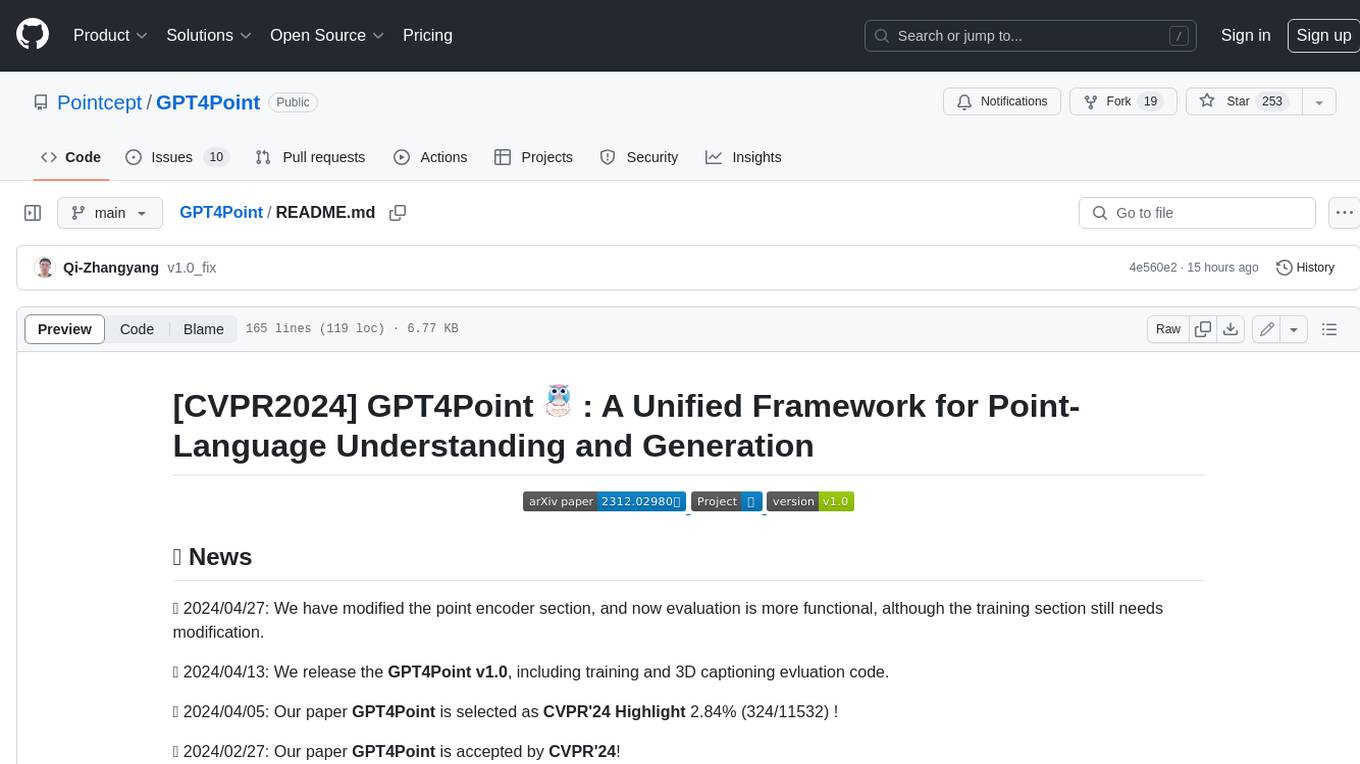
GPT4Point
GPT4Point is a unified framework for point-language understanding and generation. It aligns 3D point clouds with language, providing a comprehensive solution for tasks such as 3D captioning and controlled 3D generation. The project includes an automated point-language dataset annotation engine, a novel object-level point cloud benchmark, and a 3D multi-modality model. Users can train and evaluate models using the provided code and datasets, with a focus on improving models' understanding capabilities and facilitating the generation of 3D objects.
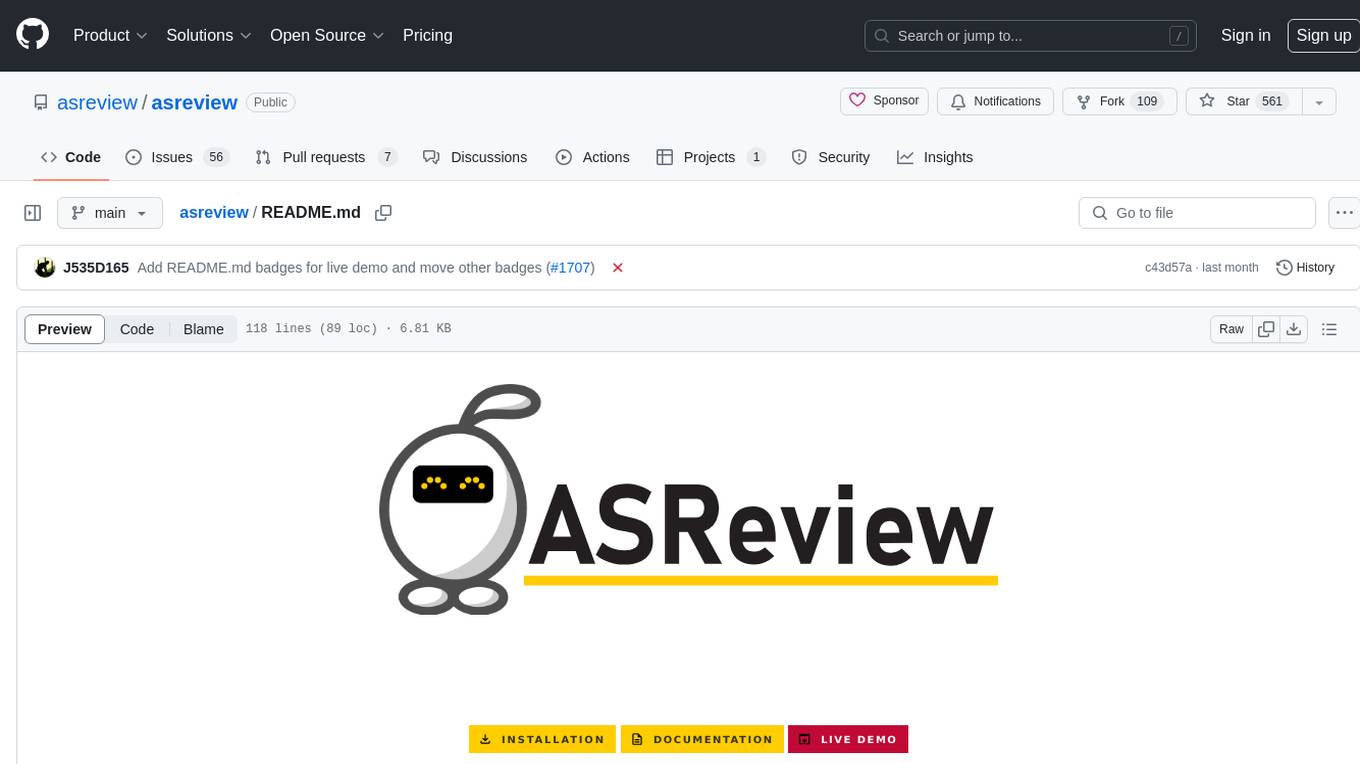
asreview
The ASReview project implements active learning for systematic reviews, utilizing AI-aided pipelines to assist in finding relevant texts for search tasks. It accelerates the screening of textual data with minimal human input, saving time and increasing output quality. The software offers three modes: Oracle for interactive screening, Exploration for teaching purposes, and Simulation for evaluating active learning models. ASReview LAB is designed to support decision-making in any discipline or industry by improving efficiency and transparency in screening large amounts of textual data.
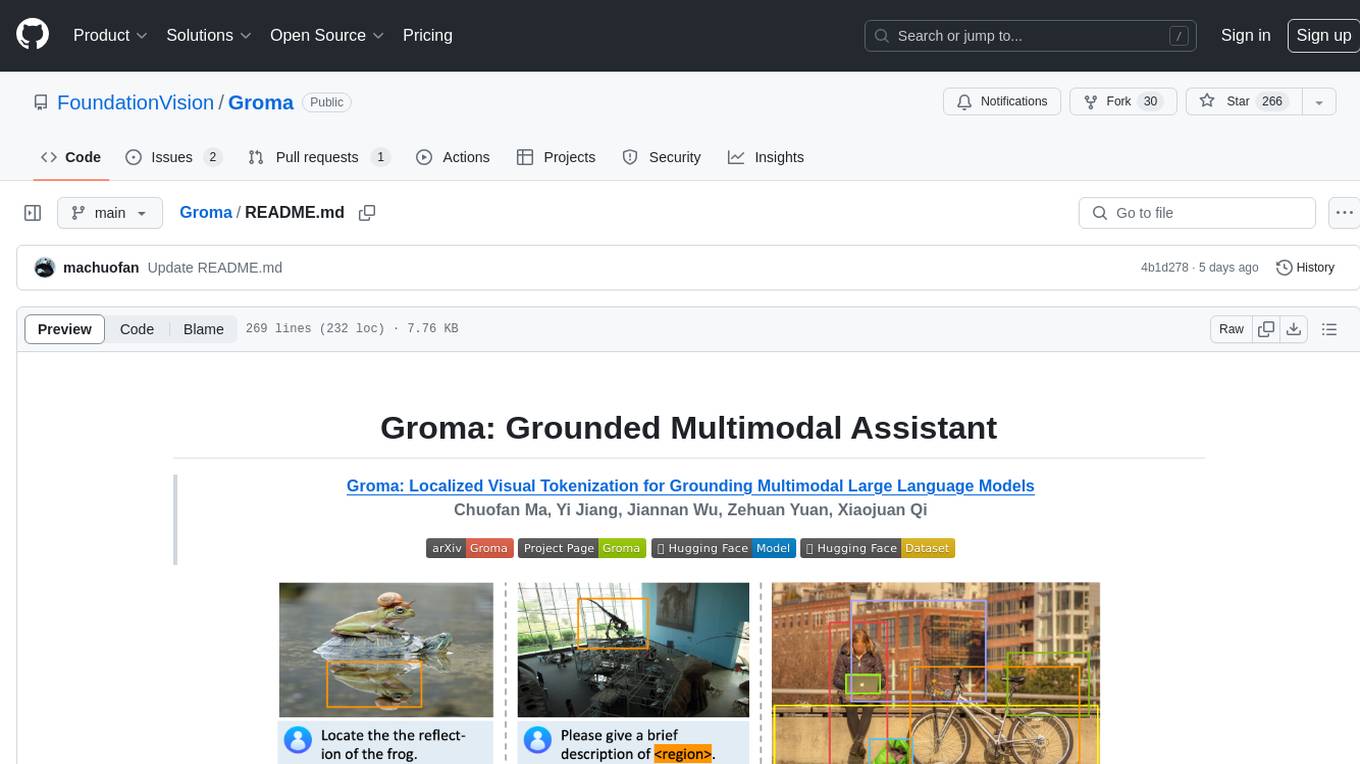
Groma
Groma is a grounded multimodal assistant that excels in region understanding and visual grounding. It can process user-defined region inputs and generate contextually grounded long-form responses. The tool presents a unique paradigm for multimodal large language models, focusing on visual tokenization for localization. Groma achieves state-of-the-art performance in referring expression comprehension benchmarks. The tool provides pretrained model weights and instructions for data preparation, training, inference, and evaluation. Users can customize training by starting from intermediate checkpoints. Groma is designed to handle tasks related to detection pretraining, alignment pretraining, instruction finetuning, instruction following, and more.
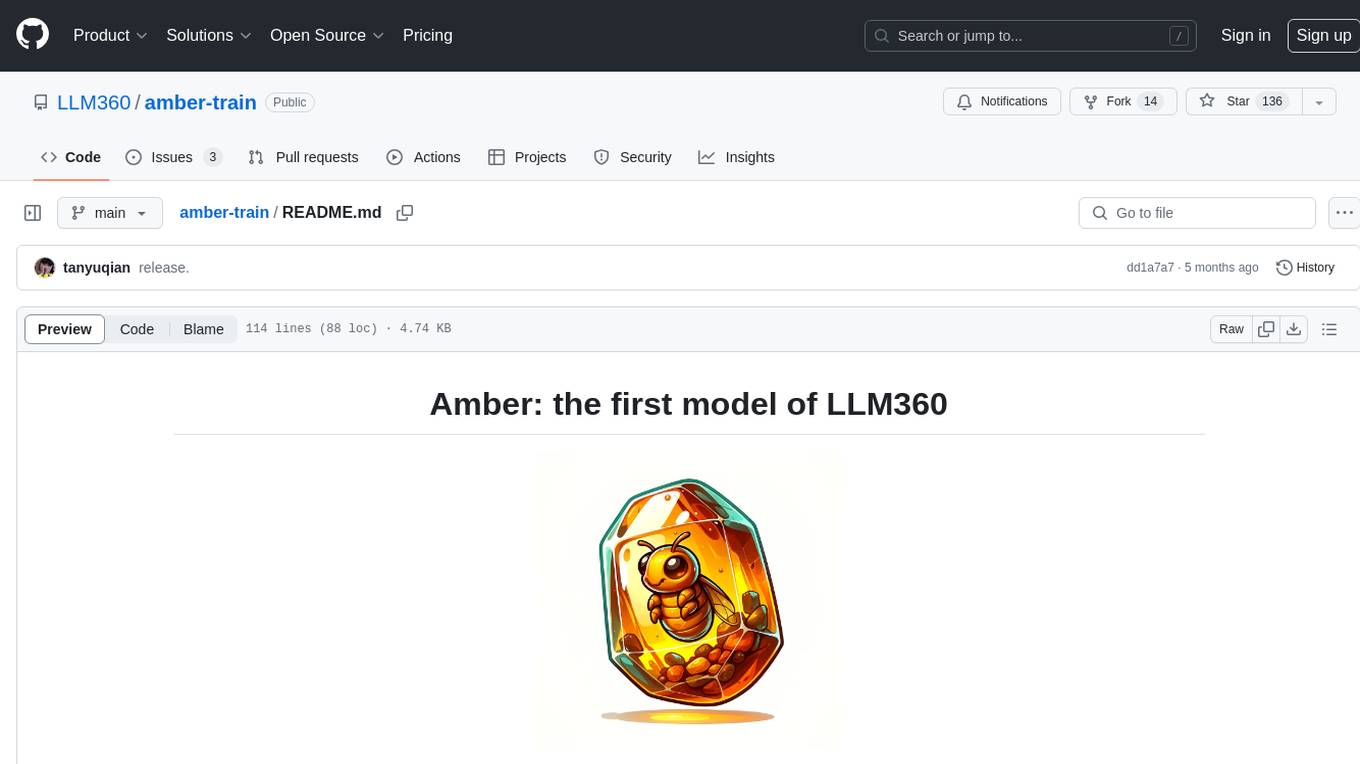
amber-train
Amber is the first model in the LLM360 family, an initiative for comprehensive and fully open-sourced LLMs. It is a 7B English language model with the LLaMA architecture. The model type is a language model with the same architecture as LLaMA-7B. It is licensed under Apache 2.0. The resources available include training code, data preparation, metrics, and fully processed Amber pretraining data. The model has been trained on various datasets like Arxiv, Book, C4, Refined-Web, StarCoder, StackExchange, and Wikipedia. The hyperparameters include a total of 6.7B parameters, hidden size of 4096, intermediate size of 11008, 32 attention heads, 32 hidden layers, RMSNorm ε of 1e^-6, max sequence length of 2048, and a vocabulary size of 32000.
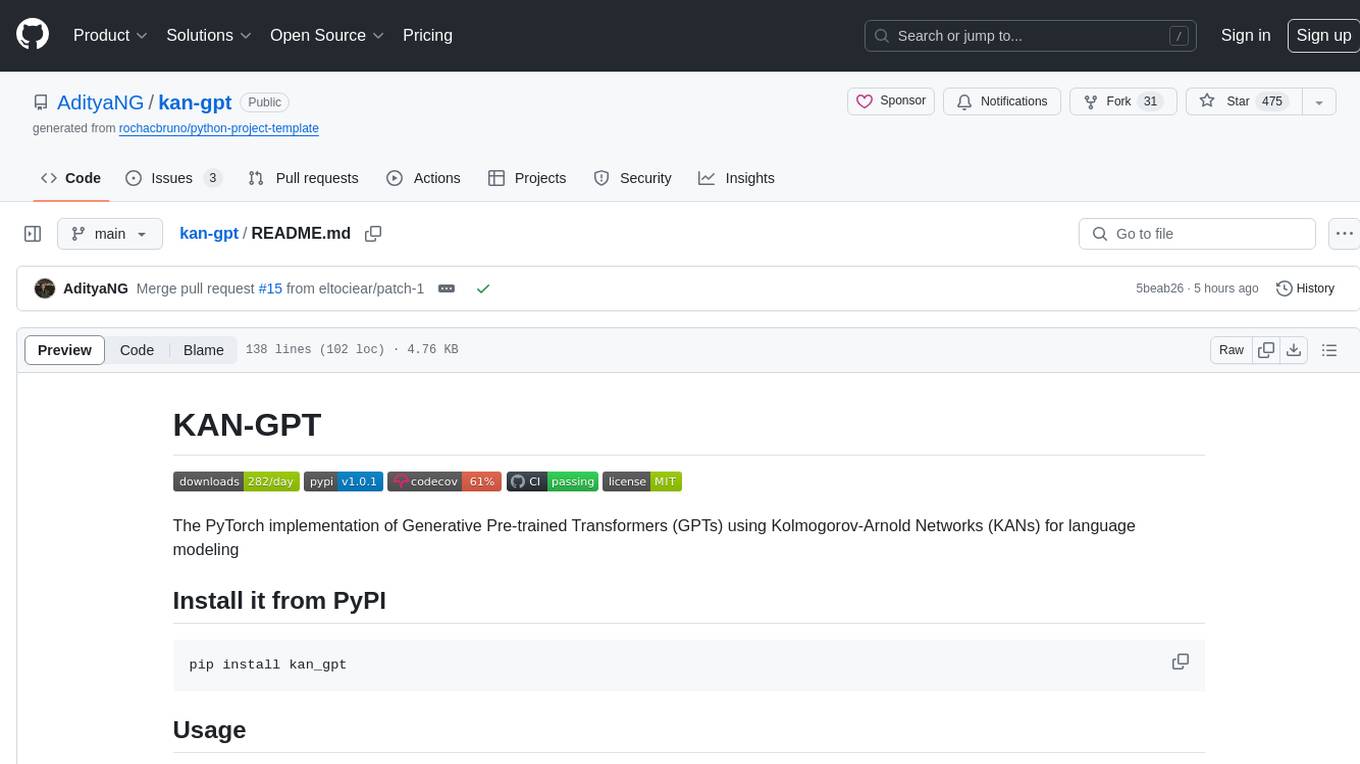
kan-gpt
The KAN-GPT repository is a PyTorch implementation of Generative Pre-trained Transformers (GPTs) using Kolmogorov-Arnold Networks (KANs) for language modeling. It provides a model for generating text based on prompts, with a focus on improving performance compared to traditional MLP-GPT models. The repository includes scripts for training the model, downloading datasets, and evaluating model performance. Development tasks include integrating with other libraries, testing, and documentation.
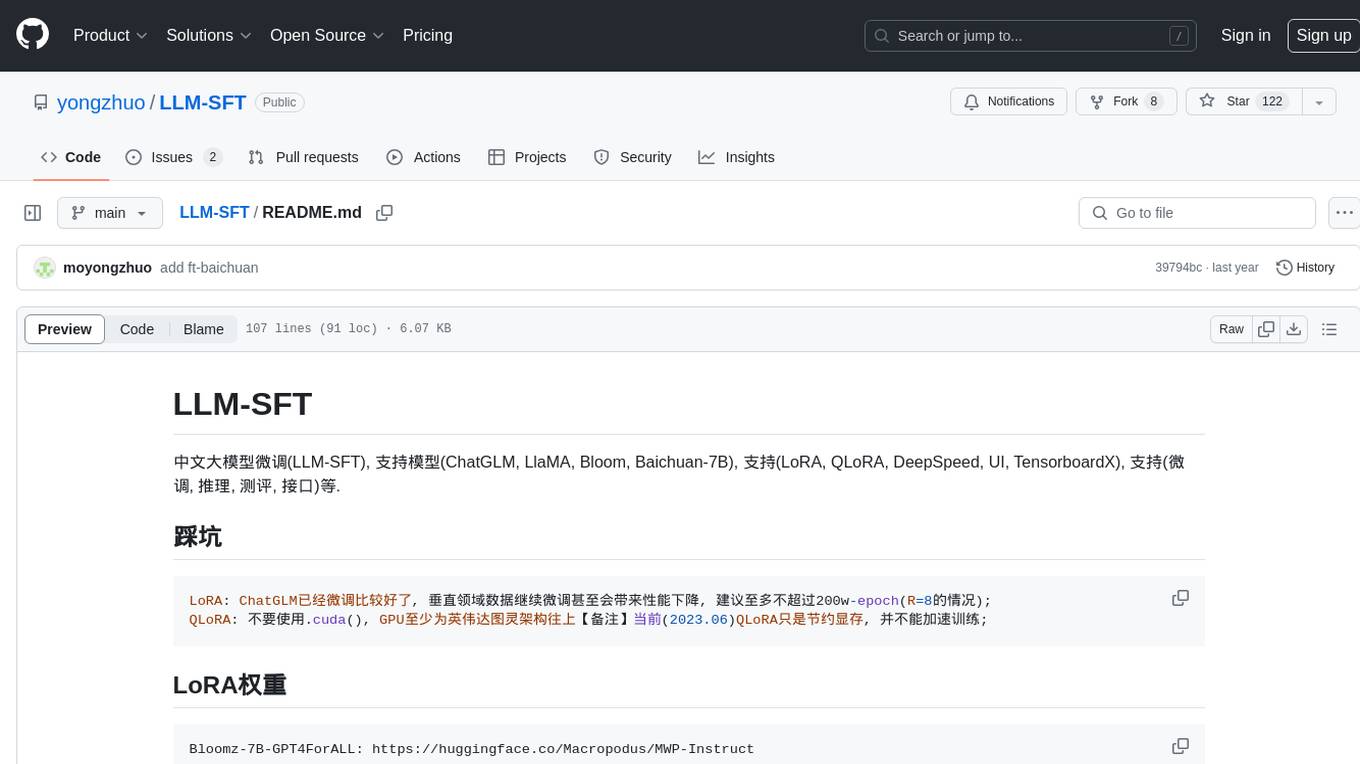
LLM-SFT
LLM-SFT is a Chinese large model fine-tuning tool that supports models such as ChatGLM, LlaMA, Bloom, Baichuan-7B, and frameworks like LoRA, QLoRA, DeepSpeed, UI, and TensorboardX. It facilitates tasks like fine-tuning, inference, evaluation, and API integration. The tool provides pre-trained weights for various models and datasets for Chinese language processing. It requires specific versions of libraries like transformers and torch for different functionalities.
For similar jobs

weave
Weave is a toolkit for developing Generative AI applications, built by Weights & Biases. With Weave, you can log and debug language model inputs, outputs, and traces; build rigorous, apples-to-apples evaluations for language model use cases; and organize all the information generated across the LLM workflow, from experimentation to evaluations to production. Weave aims to bring rigor, best-practices, and composability to the inherently experimental process of developing Generative AI software, without introducing cognitive overhead.

LLMStack
LLMStack is a no-code platform for building generative AI agents, workflows, and chatbots. It allows users to connect their own data, internal tools, and GPT-powered models without any coding experience. LLMStack can be deployed to the cloud or on-premise and can be accessed via HTTP API or triggered from Slack or Discord.

VisionCraft
The VisionCraft API is a free API for using over 100 different AI models. From images to sound.

kaito
Kaito is an operator that automates the AI/ML inference model deployment in a Kubernetes cluster. It manages large model files using container images, avoids tuning deployment parameters to fit GPU hardware by providing preset configurations, auto-provisions GPU nodes based on model requirements, and hosts large model images in the public Microsoft Container Registry (MCR) if the license allows. Using Kaito, the workflow of onboarding large AI inference models in Kubernetes is largely simplified.

PyRIT
PyRIT is an open access automation framework designed to empower security professionals and ML engineers to red team foundation models and their applications. It automates AI Red Teaming tasks to allow operators to focus on more complicated and time-consuming tasks and can also identify security harms such as misuse (e.g., malware generation, jailbreaking), and privacy harms (e.g., identity theft). The goal is to allow researchers to have a baseline of how well their model and entire inference pipeline is doing against different harm categories and to be able to compare that baseline to future iterations of their model. This allows them to have empirical data on how well their model is doing today, and detect any degradation of performance based on future improvements.

tabby
Tabby is a self-hosted AI coding assistant, offering an open-source and on-premises alternative to GitHub Copilot. It boasts several key features: * Self-contained, with no need for a DBMS or cloud service. * OpenAPI interface, easy to integrate with existing infrastructure (e.g Cloud IDE). * Supports consumer-grade GPUs.

spear
SPEAR (Simulator for Photorealistic Embodied AI Research) is a powerful tool for training embodied agents. It features 300 unique virtual indoor environments with 2,566 unique rooms and 17,234 unique objects that can be manipulated individually. Each environment is designed by a professional artist and features detailed geometry, photorealistic materials, and a unique floor plan and object layout. SPEAR is implemented as Unreal Engine assets and provides an OpenAI Gym interface for interacting with the environments via Python.

Magick
Magick is a groundbreaking visual AIDE (Artificial Intelligence Development Environment) for no-code data pipelines and multimodal agents. Magick can connect to other services and comes with nodes and templates well-suited for intelligent agents, chatbots, complex reasoning systems and realistic characters.

